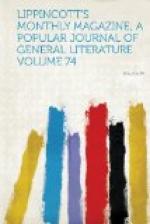[Illustration: The rolls.]
To carry on this process properly requires great skill and judgment in the puddler. The heat necessarily generated by the operation is so great that very few persons have the physical endurance to stand it. So great is it that the clothes upon the person frequently catch fire. Such a strain upon the physical powers naturally leads those subjected to it to indulge in excesses. The perspiration which flows from the puddlers in streams while engaged in their work is caused by the natural effort of their bodies to preserve themselves from injury by keeping their normal temperature. Such a consumption of the fluids of the body causes great thirst, and the exhaustion of the labor, both bodily and mental, leads often to the excessive use of stimulants. In fact, the work is too laborious. Its conditions are such that no one should be subjected to them. The necessity, however, for judgment, experience and skill on the part of the operator has up to this time prevented the introduction of machinery to take the place of human labor in this process. The successful substitution in modern times of machines for performing various operations which formerly seemed to require the intelligence and dexterity of a living being for their execution, justifies the expectation that the study now being given to the organization of industry will lead to the invention of machines which will obviate the necessity for human suffering in the process of puddling. Such a consummation would be an advantage to all classes concerned. The attempts which have been made in this direction have not as yet proved entirely successful.
In the squeezer the glowing ball of white-hot iron is placed, and forced with a rotary motion through a spiral passage, the diameter of which is constantly diminishing. The effect of this operation is to squeeze all the slag and cinder out of the ball, and force the iron to assume the shape of a short thick cylinder, called “a bloom.” This process was formerly performed by striking the ball of iron repeatedly with a tilt-hammer.




